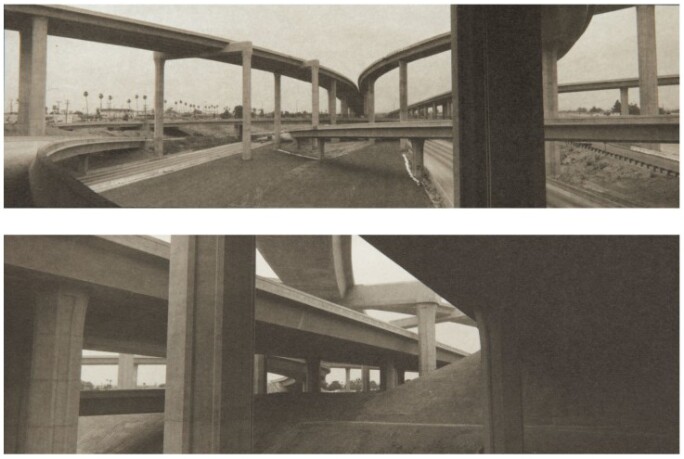‘I’m really interested in the structure of communities.’
Catherine Opie’s Icehouses series (2001) resulted from two months of photographing in northern Minnesota. She often withstood severe weather conditions for hours at a time, waiting for each exposure as only blizzards yielded the white-on-white aesthetic she sought. Opie produced this series during her yearlong residency at the Walker Art Center, when she was concurrently working on her Skyways series (2001) in Minneapolis. She conceptualized both series as a continuation of her 'American Cities' project.
Although Opie has consistently explored the motif of communities throughout her career, the majority of her landscapes and cityscapes are devoid of human presence. The implication of community in images absent of people forces viewers to examine the semiotics of the landscape and architecture to make their own assumptions about the community that likely inhabits them.

Opie expands the boundaries of documentary photography by pushing her practice in a more conceptual direction through her re-contextualization of the way we view our surroundings, often through her unorthodox vantage points (Opie and Drohojowska-Philp, 37). The unique spatial perspectives inherent to Opie’s work marks another formal continuity throughout her practice. For Wall Street (2001), Opie chose a panoramic horizontal perspective to frame a city recognized for its verticality, while for Freeways (1994-95) she shot from a vantage point below the expressways, thereby elevating the banal roadways to a grand stature.
To capture ice fishing cabins in the midst of an immensely broad landscape, she elected to shoot in a vertical format using an 8-by-10 field camera. The fourteen 50-by-40 inch chromogenic prints that comprise the series are unified by a continuous horizon line bisecting the nearly monochromatic white sky above and frozen lake below. When the series was exhibited in its entirety at the Walker Art Center (2001) and Regen Projects (2002), the works were hung in close proximity in a single line to form an extended landscape dotted with minuscule colorful ice houses and characterized by a sense of quietude. The series begins with Untitled # 1, which depicts a multitude of ice houses in the foreground. The subsequent images present a progressively obscured field of vision due to blizzard conditions. In the culminating work, Untitled # 14, only the slightest trace of a colored structure is visible through the winter storm. In the present work, Untitled #9 (Icehouses), a sole red house glows in a landscape of otherwise uniform whiteness.

In the exhibition catalogue for the artist’s 2008-09 Guggenheim retrospective, curator Nat Trotman noted that in comparison to her prior landscapes and street photography, in Icehouses the 'man-made forms do not dominate the scenes but find themselves at the mercy of the natural landscape at which they depend' (Blessing and Trotman,184). The diminutive quality of the houses juxtaposed against the magnitude of the landscape in the latter half of the series in particular presents viewers with a boundlessness of nature best described as sublime.
‘I realized that I could do something with true documentary, but conceptually move it to this place that also bumped up against Minimalist painting.’

(right) Fig. 2 Robert Ryman, Untitled, 1961, sold: Sotheby’s, New York, 11 November 2014 for $15,005,000
While clearly a continuation of the documentary approach that characterizes her practice, the movement towards abstraction in Icehouses marked an aesthetic shift that Opie further built upon in her subsequent series, Surfers (2003). With the surfers, Opie likewise progresses from clarity towards obscurity throughout the fourteen seascapes, each executed with a consistent horizon line. Similar to the transient nature of ice fishing cabins, surfers embody temporary colonies that connect with Opie’s larger examination of the structure of communities (see Lot 6 in 'Contemporary Photographs' sale, closing 5 October).
Curator Douglas Fogel describes the arc of Opie’s artistic career as ‘one long road trip across this continent in search not of the American dream, but rather a dream of an idea of American community' (Fogle, 5).
To partake in owning part of the series constitutes another form of community – one that includes the Museum of Contemporary Art, Los Angeles; the Whitney Museum of Art, New York; UCLA’s Hammer Museum, Los Angeles; Harvard’s Fogg Museum,Cambridge; and Walker Art Center, Minneapolis.